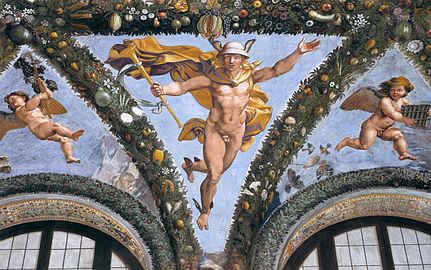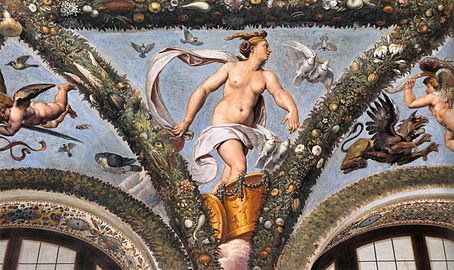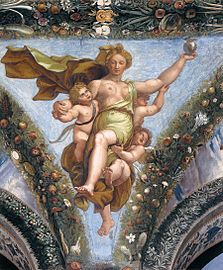Villa Farnesina
The Villa Farnesina (also Villa della Farnesina or short Farnesina called) was the Tuscan banker and businessman Agostino Chigi as an expression of his wealth and humanistic, artistic and life from 1508 to 1511 by Baldassare Peruzzi in Rome's Trastevere built. Well-known artists of the early 16th century such as Raffael , Sebastiano del Piombo , Giovanni Antonio Bazzi (called Sodoma ), Giulio Romano , but also Peruzzi himself furnished the rooms. In 1579 it passed into the possession of Cardinal Alessandro Farnese , from whom it took its name.
With its stylistic harmony and its elegance, it is one of the most important secular buildings of the High Renaissance in Rome and, with its architecture, artistic furnishings and gardens, forms a total work of art from this period. Today the villa is owned by the Accademia dei Lincei and partly accessible as a museum. Here is the Gabinetto Nazionale delle Stampe , the state graphic collection.
Location and location
Location in the urban area of Rome
In 1500 the Via Janiculensis from the Porta Septimiana through the Porta Santo Spirito to the Borgo was only a land route with sparse buildings. Pope Julius II had the road straightened and named it Lungara. At its end, near the Porta Septimiana, the Riario and Farnese families had country houses and vineyards. Agostino Chigi bought a piece of land there in May 1505 that reached as far as the Tiber and on which the villa was later built.
Today the villa is in a triangle between Via della Lungara 230 and Lungotevere Farnesina and is still surrounded by a park. The former access to the Tiber was lost due to the erection of the protective walls in the 1880s and the main road along the Tiber. On the opposite side of Via Lungara is the Palazzo Corsini , built in the 18th century and now home to the Accademia Nazionale dei Lincei ( Italian Academy of Sciences ). The embedding in the property and the location on the river reveal the ancient model of a villa suburbana, which combines representation and seclusion in the private.
Garden of the Farnesina
In keeping with the taste of the Cinquecento, the palace was surrounded by a garden, in the south of the Giardino segreto and towards the Tiber, adapted to the terrain, etc. a. an ornamental garden as well as vineyards and orchards such as those owned by those who were self-conscious in Rome. To the north of the villa on the banks of the Tiber there was a loggia or pergola and a grotto , also part of a pleasure garden of the time. Some literary sources and poems give a picture of the rich variety of flowers and plants.
Peruzzi's plans are not available for the original garden program, but it can be assumed that the building and garden were planned as a whole. The basic concept, the unity between nature and art, for the edification of body and mind, an ideal already striven for in antiquity, was the inspiration. In the course of time, the gardens and their dimensions changed again and again, as documented by some vedute and engravings that were created in the course of time .
There is probably an inscription in the garden from the 17th century, the origin and meaning of which has not been identified: “Quisquis huc accedis: quod tibi horridum videtur mihi amoenum est; si placet, maneas, si taedet abeas, utrumque gratum ” , roughly translated: Whoever you approach here: What seems scary to you is lovely to me. If (you) like it, you may stay; if (you) are disgusted, you may go - both is fine (me).
The Casa della Farnesina
An ancient villa from the early imperial era, the so-called Casa della Farnesina , was discovered under the gardens of the villa and Via della Lungara .
This system was discovered in 1880 when the banks of the Tiber were being fortified. So far only part of the villa under the garden has been excavated. It is believed that this villa urbana was built on the occasion of the wedding between Marcus Vipsanius Agrippa and Iulia , the daughter of Augustus . The wall paintings and stucco reliefs uncovered in the course of the excavations are now in the Museo Nazionale Romano - Palazzo Massimo.
History of the building
Builder and owner
Agostino Chigi (* 1466; † 1520), from a rich banking family from Siena , was an influential, ambitious personality with an exceptional business acumen as well as an important art patron in Rome at the beginning of the 16th century, with excellent connections to the Papal States. He secured his social advancement under Pope Alexander VI. Who gave him the papal salt pans and the Alaunabbau in Tolfabergen leased. He also enjoyed the protection of the subsequent Popes Julius II and Leo X , with whom he not only shared financial interests, but also an enthusiasm for the arts and antiquity. In 1509 Pope Julius II took Agostino Chigi into the papal family and allowed him to use the Della Rovere family oak in his coat of arms.
Owned by Agostino Chigis
After purchasing the property, Chigi commissioned the well-known architect and artist Baldassare Peruzzi, also from Siena, to build the villa. Living in a country house outside the city, the Villeggiatura, was a typical way of life in the Italian Renaissance period. The idea goes back to ancient models (e.g. Cicero - Villa am Tusculum) and writings in which the idea played an important role in achieving the connection between agriculture, recreation and study with the cultivated way of life of the townspeople.
Construction began on April 22, 1506, probably due to a supposedly favorable planetary constellation and also because this date was held for the day the city of Rome was founded. After just two years of construction, Agostino Chigi placed the first order for interior decoration with Peruzzi; it was the decoration of the room with the frieze. In the summer of 1511, the client was able to show Pope Julius II his elegant villa.
Pope Leo X., whose papal election he had financially supported, was also a guest in Chigis several times and was enthusiastic about the humanistic discussions, banquets and theater performances that took place in the courtyard in front of the north facade. The loggia " Amor and Psyche " served as a stage . The parties that were celebrated in the villa were legendary. The feast on the occasion of the baptism of his second son Lorenzo was the high point of extravagance and luxury. There was not only the most unusual dishes; after use, the silver dishes were thrown into the Tiber . Allegedly, Agostino Chigi had stretched nets in the river as a precaution and had the valuable tableware collected again later. The last of the traditional celebrations took place on the occasion of the wedding between Agostino Chigi and Francesca Ordeaschi, in the presence of Pope Leo X, on August 28, 1519 in the “Sala delle Prospettive”.
The artists Sodoma, Sebastiano del Piombo and Pietro Aretino lived at times as guests in the building.
From 1511 Chigi lived in the villa with his second young wife, Francesca Ordeaschi, whom he only married in 1519, as well as his two sons and two daughters. On the occasion of his wedding, he read out his will, which has been preserved to this day. The dispositions of the villa took up a lot of space, among other things, the property should never be pledged or sold and so the name Chigi should remain forever associated with the villa. When Agostino Chigi died on April 11, 1520, the heirs of the villa were his two sons Alessandro Giovanni and Lorenzo Leone.
Takeover by Farnese
Seven months after Chigi's death, his wife died, one year later the eldest son Alessandro Giovanni, and in 1523 the posthumously born son Agostino. The builder's brother, Sigismondo, moved into the villa with his family, but left it shortly before his death in 1526. Immediately before the Sacco di Roma in 1527, according to a census, 22 people lived in the building. In 1577 the auction of the villa was scheduled, but was made superfluous by the purchase contract with Cardinal Alessandro Farnese . He had been interested in the villa for a long time, as it represented a valuable addition to his adjoining vineyard, the Vigna Farnese. The Farnese family owned the famous Palazzo Farnese in Rome and the Palazzo Farnese in Caprarola - Alessandro Farnese, who later became Pope Paul III , had both buildings . erect. The Farnese planned to connect the Roman Palazzo Farnese with the Villa della Farnesina by a bridge over the Tiber. Of this project, however, only the first bridge arch over the Via Giulia - still visible today - was carried out in 1603 .
Until 1626, the Roman family branch of the Farnese used the villa, which was inherited by the Dukes of Parma , the ruling ducal house of the Farnese in Parma and Piacenza. They rented these to prominent guests, such as Cardinal Richelieu in 1633 , Cardinal Friedrich von Hessen-Darmstadt in 1652 , Queen Christine of Sweden in 1655/56 and, from 1661, to the French ambassador of Louis XIV.
Further ownership history
The first renovation of the palace and the closing of the loggias with glass doors to protect against the weather took place around 1650. At the end of the 17th century, the Duke of Parma initiated further renovations. In 1731 the French royal house of the Bourbon family took over the duchy and with it the villa after the Farnese died out. Then it fell to Charles IV of Naples and both Sicilies and continued to serve as accommodation for high dignitaries at court or in the curia. In the period from 1741 to 1747 further renovation work was carried out on the villa and the rooms and loggias were furnished with valuable antiques from Palazzo Farnese. In the engravings by Giuseppe Vasi one can see the external condition at this time.
In 1864, the Villa Farnesina was the residence of the Spanish ambassador in Naples, Salvador Bermúdez de Castro , Prince of Ripalta, who bought it on a long lease, renovated it fundamentally and had structural changes made. This included the relocation of the main entrance and the creation of the vestibule at the south entrance, the modification of the Belvedereloggia and the new layout of the garden. In 1927 the Kingdom of Italy acquired the villa, which made it the seat of the Accademia d'Italia and in 1944 transferred the property rights to the Accademia dei Lincei , the Academy of Sciences founded by Prince Cesi in 1603 . This, housed in the Palazzo Corsini opposite , she used for official receptions. In addition, the Gabinetto Nazionale delle Stampe has been located there since 1950, with an important graphic collection for prints and drawings, as part of the Istituto Nazionale per la Grafica .
From 1969 to 1973 the Istituto Centrale del Restauro carried out restorations again. The renovation work on the external facades was completed in 2013.
architecture
The two-wing palace, designed by Baldassarre Peruzzi based on the example of the Villa Chigi alle Volte near Siena, was long regarded in the 16th century as a model for a stately representative country house in terms of its architectural structure, its harmonious proportions and its artistically designed gardens. For Roman villa architecture, it marked the transition from the early to the high Renaissance .
The floor plan of the building is a simple, clearly designed U-shape, the wings of which are proportionally designed and are reminiscent of the risalits of the palace construction of that time. The villa has 2 loggias and a total of 40 rooms spread over 2 floors and 2 mezzanines . Architectural changes in the room layout have already been made by Peruzzi himself, for example in the “Hall of Perspectives”, which was expanded to the west. The restorations of the 17th and especially the 18th and 19th centuries led to further changes; so the loggias were closed and the room layouts changed.
Above the eastern side wing towards the Tiber there is still a Belvedere loggia, which originally had five axes, but was reduced to three axes during the renovation of the building in 1861–1863. The living and guest rooms were probably located in the second mezzanine. The kitchen of the villa was under the loggia of the Galathea .
After he was able to purchase the property north of the villa in 1510, Chigi had a stables built according to a design by Raphael, as Vasari notes in his artist biography. This was probably never completed and was demolished in 1808 after a long period of dilapidation, which was caused by construction defects in the initial phase. A loggia on the banks of the Tiber, which probably fell victim to the heavy flooding in 1531, was also designed by Raffael.
Construction / floor plans
Construction sketches or other written documents from Peruzzi for the villa have not been preserved. However, the Archivio Chigi still has records of the construction process and the explanations. These and the empirical analyzes of the villa by Christoph Luitpold Frommel reveal the laws of proportionality applied by Peruzzi, on which the building is based. Essential and aesthetically defining elements of the building and especially the facades were created strictly mathematically according to the proportional ratio 1: 2 or 2: 1, including the side wings, the clear dimensions of the windows on both main floors and the clear dimensions of the arcades. At the same time, the square can be found repeatedly as a geometric element, e.g. B. in room floor plans and facade structures. August Thiersch described this fundamental principle of classical architecture, but especially of the Italian Renaissance, as the law of similair.
Exterior design
The facades are clearly structured, with elegant Doric pilasters structuring the horizontal surfaces between the rectangular windows. Striking cornices separate the two main floors from each other. Visually, the stucco band around the building, richly decorated with putti , fruits and garlands , catches the eye and gives the garden palace lightness and harmony. Strictly classic is the odd number of axes - nine on the long sides, seven on the transverse axes of the building - with an emphasis on the center. The west facade facing the street is representative and closed, but without developing any particular effect. The exterior facades were originally painted, but they are no longer preserved. In 1509 Peruzzi received the order for this, which is documented by drawings.
The various building materials and their use on the facades are interesting. The main cornice is made of gray-green peperino , the figure and garland frieze are made of terracotta , the architrave and the pilaster capitals are again made of peperino. Some of the pilasters are finely carved out of bricks, while the corner pilasters are again made of peperino stones; the window frames on the upper floor, the parapets and plinths, the cornices, the arcade arches and the window frames on the ground floor are also made of Peperino. The wall surfaces on both floors are plastered and the paintwork has been changed from ocher to sand since 2012.
North facade
The entrance to the villa was originally on the north side, "where the arbors and pavilions of the garden merged into the painted green garlands of the loggia of Cupid and Psyche, creating an impressive symbiosis with the architecture." The facade with its five arcades and the two space-creating side wings forms the impressive view of the villa and thus breaks through the austerity of the exterior design. In the 19th century the entrance was moved to the south side, whereby the loggia "Amor und Psyche" lost its function as a vestibule.
South facade
The strictly structured, even facade is divided into two cornices by pilaster strips . The rules of the golden ratio can be seen in the horizontal structure . The positioning of the mezzanine - in the ground floor area below the first pilaster, in the area of the piano nobile over the last pilaster in the frieze - lets this recede in its effect and the windows appear as a decorative element.
Interior fittings
Chigi had the representative rooms and loggias fitted out with frescoes on the walls and ceilings, taking up themes from the world of antiquity, the world of symbols and myths and astrology. In 1508 he gave Peruzzi the first order to design the “hall with the frieze”, which was intended for important ceremonies and as a waiting room for guests. In 1511 Peruzzi began to decorate the loggia of Galatea , the program of which the humanist Cornelio Benigni worked out based on the horoscope of Agostino Chigis and Peruzzi translated into pictures. In the same year Chigi brought the young Sebastiano del Piombo with him from Venice, who contributed to the decoration of the loggia with the Metamorphoses of Ovid and the giant Polyphemus . Drawing on the same source, Raffael created the distinctive figure of Galatea.
After a break of five years and in preparation for his wedding, Chigi placed the order with Raffael for the entire decoration of the vestibule loggia. Vasari reports that Agostino Chigi allowed him to have his girlfriend (presumably Fornarina) with him at work in order to speed up the work. The only requirements for the artist were that the topic should be oriented towards the upcoming wedding and that the implementation should be impressive for the distinguished guests. The choice fell on the fairy tale " Cupid and Psyche ", which culminates with the wedding on Mount Olympus . At the same time, renovations were carried out on the couple's bedroom on the upper floor. Here, too, the cycle of frescoes with the wedding of Alexander the Great with Roxane is tailored to the importance of the space and accompanied by symbolic scenes. At the same time, Peruzzi worked on the “Hall of Perspectives” and, surrounded by elegant pseudo-architecture, created amazing perspective views of the city and landscape. The banker's wedding took place in this room in 1519.
“Thanks to the combination of Raphael's excellent compositional skills, Peruzzi's meditation on antiquity and the airy blaze of colors of Piombo, the host was able to entertain his guests not only with mythological episodes and their symbolic meaning, but also with the expressive and stylistic talents of the three greatest painters of his time discuss, which he had brought together at the moment of the most perfect maturity of their artistic abilities to bestow fame and honor on the house of the Chigi dynasty. "
Loggia of Cupid and Psyche
This elongated hall owes its name to the frescoes that Raphael and his students executed on the ceiling and in the spandrels in 1518 . They are inspired by the fairy tale Amor and Psyche from the novel "The Golden Donkey" by Apuleius . All scenes are surrounded by garlands with lifelike plants, flowers and fruits, which transform the entrance loggia into an arbor. This interpenetration of house and garden with stylistic natural elements was in great demand at this time and was masterfully implemented by Giovanni da Udine .
In the center of the ceiling, the highlights of the fairy tale are shown in two long fields delimited by flower garlands. The pictures in the spandrels were made by his students based on designs by Raphael; the small spandrels show allegorical representations with putti.
- Central ceiling images
- Eastern and western ceiling part
- Southern part of the ceiling
- Northern part of the ceiling
Galatea's loggia

This room was named after the famous Raphael fresco. The remaining paintings in this room are works by Sebastiano del Piombo and Baltassarre Peruzzi.
On the west side is The Triumph of Galatea , a masterpiece by Raphael, created in 1511 and 1512. It shows Galatea in the sea on a shell as a vehicle, pulled by two dolphins, surrounded by tritons and many sea gods. Raphael explains in a letter to Baldassare Castiglione that - in order to give life to the beautiful main character of the painting - he looked at various extremely beautiful women; in the end, however, came up with a model. It was obviously Agostino's longtime courtesan Imperia Cognati . Next to the Galatea is her lover, the one-eyed giant Polyphemus, executed by Sebastiano del Piombo in 1512.
In the 17th century, the furnishings of the room were supplemented by landscape paintings. The fresco paintings in the hall were revised in 1863 and restored from 1969 to 1973.
Bezels
Sebastiano del Piombo also created eight of the ten images in the lunettes that show scenes from Ovid's Metamorphoses:
|
|
Ceiling painting
The complex program of images on the ceiling, executed by Baldassarre Peruzzi in 1511, shows on the one hand mythological symbolic figures and on the other hand allusions to the horoscope of Agostino Chigi, which is based on his date of birth (December 1, 1466, 7:00 p.m.).
In the center of the ceiling there are two elongated octagonal fields in which fame and its dependence on the favor of the stars are symbolically represented:
The 14 spandrels and 10 hexagons contain mythological scenes associated with certain star constellations from the Chigi horoscope:
|
|
Hall with the frieze
This room owes its name to the frieze that runs under the ceiling around the walls. It is a work by Peruzzi, who designed the room around 1508. The work of Hercules is shown on the north and part of the east side, as an allusion to the client's virtues and mythological episodes. On the coffered ceiling there are two inscriptions in cartouches from 1863, which provide information on the renovations carried out by Salvator Bermudez a Castro.
Perspectives room
Between 1518 and 1519, Peruzzi and his workshop decorated this large room with frescoes that were supposed to give the impression of a loggia. On the walls, between pseudo columns, there are views of cityscapes and fictional landscapes, in the niches above windows and doors the figures of the gods and on the north wall above the chimney the forge of the volcano . The frieze, which runs around the entire room on the upper side of the walls, is divided into long fields with representations of mythological scenes using female herms as false reliefs:
North side
East Side
South side
West side
|
|
Vasari claims to have accompanied the painter Titian on a tour of this room. At first Titian is said not to have believed that it was just paintings; a change of point of view surprised him very much.
On the walls between the pseudo-pillars there are graffiti and scribbles that were scratched by mercenaries when the villa was occupied during the Sacco di Roma in 1528. One of them reads: 1528 - what should I write and the la [nz] servants don't have a laugh. On August 28, 1519 Agostino celebrated his wedding with Francesca Ordeaschi in this room in the presence of Leo X. After the feast and the consummation of the marriage in the bedchamber (in cubiculo) he made his will here in front of the pope, twelve cardinals, four bishops, the ambassador of the Polish king and other dignitaries.
Agostino Chigi's bedchamber
Giovanni Antonio Bazzi (called Sodoma), based on an original idea by Raphael, designed this room with frescoes between 1517 and 1519. It depicts scenes from the life of Alexander the Great . The eye-catcher on the north side is Alexander's wedding with the Persian king's daughter Roxane . Sodoma designed the representation of the painting by the Greek painter Aëtion based on a description by Lucian of Samosata . It's an obvious nod to the imminent wedding camp. In the center Alexander approaching Roxane on the bed. Roxane is undressed by winged putti ; behind Alexander his half-naked companion Hephaistion and in the background the Greek god of marriage, Hymenaios , with the lit torch. On the left wall: the young Alexander tames the horse Boukephalos . On the right wall: Alexander's generosity: he receives Sisygambis , the mother of the Persian king Dareios III. and their family; including Vulcanus in the forge and putti with love arrows; a battle scene between the windows on the south side.
Reception in literature
Numerous literary mentions of the villa and its builder can be found over the centuries in poems, letters and novels - here are a few examples:
- Egidio Gallo wrote poems in “De viridario Augustinii Chigi” in 1511 on behalf of the client and created a poetic image of the building and garden.
- In “Suburbanum Augustinii Chigii Ruerae senensis”, Blosi Palladio describes the wonderful garden with its flowers and trees - also on behalf of Chigis, to give this and his house eternity.
- In a letter to Charlotte Stein, Johann Wolfgang von Goethe mentions his visit to the villa and the fresco “Amor and Psyche”. In his “Italian Journey” he reports on another visit with Angelika Kauffmann and complains about the poor restoration of the loggia.
- Ludwig I, King of Bavaria , a great lover of Italy, dedicated the sonnet "Raphael's Galathea in the Farnesina in Rome" to the villa
- Stendhal mentions the famous works of Raphael in the villa in his “Walks in Rome”.
- Emile Zola lets his protagonist rave about the loggia of the Galathea and the dreamy garden in his novel “Rome”.
literature
- Christoph Luitpold Frommel : The architecture of the Renaissance in Italy. CH Beck, Munich 2009, ISBN 978-3-406-58142-7 .
- Christoph Luitpold Frommel: The Farnesina and Peruzzi's early architectural work (= New Munich Contributions to Art History). De Gruyter, Berlin 1961, ISBN 978-3-11-003270-3 .
- The Villa Farnesina in Rome (= Mirabilia Italiae Guide). Franco Cosimo Panini, Modena 2006, ISBN 88-8290-922-0 .
- Giorgio Vasari : Le vite de 'piú eccellenti architetti, pittori, et scultori italiani, da Cimabue, insino a' tempi nostri. 2 vols., Giulio Einaudi, Turin 1991, ISBN 978-88-06-17755-3 .
- Ernst Batta: Roman palaces and villas. Insel Taschenbuch, Berlin 1992, ISBN 3-458-33024-0 .
- Mauro Lucentini: Rome, ways into the city. Pattloch, Munich 2000, ISBN 3-629-01621-9 .
- Monica Kurzel-Runtscheiner: Daughters of Venus. The courtesans of Rome in the 16th century. dtv, Munich 2001, ISBN 3-423-30805-2 .
- Guida d'Italia - Roma. Touring Club Italiano, Milan 2006, ISBN 88-365-4134-8 .
- Claudio Rendina: Cardinali e Cortigiane. Newton Compton, Rome 2007, ISBN 978-88-541-0864-6 .
- Arnold Esch: Roads to Rome. Beck'sche Reihe, Munich 2004, ISBN 3-406-51130-9 .
- Peter Murray: The Architecture of the Renaissance in Italy. Verlag Gerd Hatje, Stuttgart 1980, ISBN 3-7757-0152-4 .
- Ute Ewering: The mythological frieze of the Sala delle Prospettive in the Villa Farnesina in Rome. LIT Verlag, Münster 1993, ISBN 3-89473-308-X .
- Jacob Burckhardt : The Cicerone - Second Volume. Scientific Book Society, Darmstadt 1959
Web links
- Website of the Villa Farnesina (Italian / English)
- Website of the Accademia dei Lincei
- romeartlover.it
Individual evidence
- ^ Ferdinand Gregorovius: History of the city of Rome in the Middle Ages, chap. 376.
- ^ Pietro Aretino Ragionamento: 'Oh il bello orto; certo certo egli pò disgraziarne il giardino del Chisi in Trastevere '(Oh the beautiful garden; it can certainly compete with the garden of Chigi in Trastevere)
- ^ Villa Farnesina La Villa
- ^ According to Klaus Bartels , in Freiburger Universitätsblätter Heft 163, 43rd year (2004): Rome's speaking stones: A walk over the seven hills and through two millennia (p. 23)
- ^ M. Azzi Visentini: La villa in Italia. Quattrocento e Cinquecento.
- ^ Arnold Esch: Ways to Rome. P. 62.
- ↑ Ch. L. Frommel: The Farnesina and Peruzzi's early architectural work. P. 18 f.
- ↑ Ch. L. Frommel: The Farnesina and Peruzzi's early architectural work. P. 65.
- ^ CL Frommel: The Farnesina and Peruzzi's early architectural work. P. 54.
- ↑ Le vite. Vol. 2, p. 636.
- ^ CL Frommel: The Farnesina and Peruzzi's early architectural work. P. 65 ff.
- ^ S. Grundmann: Architecture Guide Rome. P. 130.
- ↑ The Villa Farnesina in Rome. Mirabilia Italiae Guide, p. 9.
- ↑ The Villa Farnesina in Rome. Mirabilia Italiae Guide, p. 8.
- ↑ Le vite. Vol. 2, p. 635 ff.
- ↑ The Villa Farnesina in Rome. Mirabilia Italiae Guide, p. 10.
- ↑ Raphael's preliminary drawings and detailed studies for these frescoes are preserved in several museums: Albertina Graphic Collection , Vienna; Scottish National Gallery , Edinburgh (ill.) ; Royal Collection of her Majesty Queen Elizabeth II (fig.) ; Teylers Museum , Haarlem
- ↑ Vasari: Le Vite. Vol. 4.
- ↑ Ch. L. Frommel: The Farnesina and Peruzzi's early architectural work. P. 1.
- ↑ Le vite. Vol. 2, p. 685.
- ^ Arnold Esch: Ways to Rome. P. 62.
- ↑ Commentario di Alessandro VII. Sulla vita di Agostino Chigi il Magnifico:… ac tales tantosque adhibuit testes, quales nemo alius, vel Rex, vel Imperator, ab orbe condito ad nostrum usque aetatem
- ↑ A red chalk drawing as a preliminary study for Alexander's wedding is in the Albertina Graphic Collection in Vienna (Inv.No. 17634)
- ↑ Ute Ewering: The mythological frieze of the Sala delle Prospettive in the Villa Farnesina in Rome. P. 100.
- ↑ JW v. Goethe: Letters to Charlotte Stein. Vol. 2, tredition GmbH, ISBN 978-3-8424-2157-8 .
- ↑ JW v. Goethe: Italian journey. G. Grothe'sche Verlagbuchhandlung, 1870.
- ^ Ludwig I .: Poems. JG Cotta'sche Buchhandlung 1839.
- ^ Stendhal: Walks in Rome. Propylaea, 1921.
- ^ Emile Zola: Rome. Vol. II, Dt. Publishing house 1900.
Coordinates: 41 ° 53 '36.6 " N , 12 ° 28' 2.8" E























